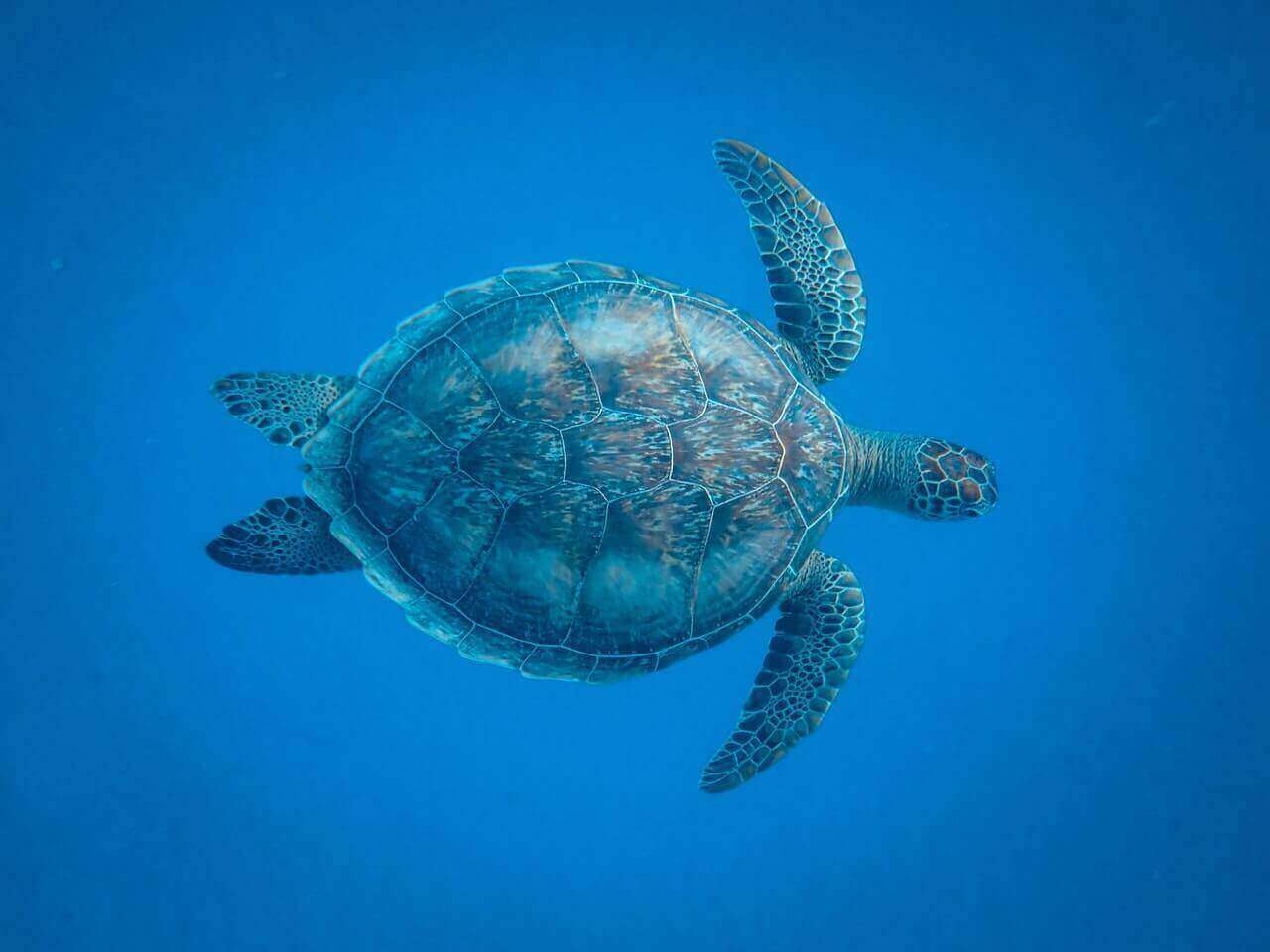One of the most fascinating things about turtles is their ability to go into their shells. After witnessing this phenomenon, most people are left with a number of questions, key among them being on why turtles hide in the shells. Read on, for answers.
Why do turtle hide in their shells? Turtles hide in their shells when they feel threatened, as a defense mechanism. There is also a theory which holds that turtles go into their shells as a food hunting strategy. While they are in their shells, they are unrecognizable to their prey. They can therefore wait until the prey comes close enough, then attack.

Do All Turtles Have Shells?
Before proceeding to answer the why do turtle hide in their shells question at greater length, it is important to first understand whether all turtles have shells.
As it turns out, all turtles do indeed have shells. The shape and structure of the shell may vary from one type of turtle to another. But they all have shells. The shells are made of vertebrae and ribs, and are as such an integral part of the turtles’ bodies.
Can Turtles Go Into Their Shells?
Another key question we need to deal with, before proceeding to tackle the one on why do turtle hide in their shells is on whether turtles really have the ability to hide in their shells.
So, indeed, can turtles go into their shells? Can turtles retract into their shells in real life? The answer is yes. Turtles have the ability to go into their shells – though the extent to which they do so varies from one type of turtle to the next.
For instance, many land and freshwater turtles are able to fully go inside their shells. This includes hiding their heads and legs. So this is where you find a turtle hiding in shell fully: to an extent where it is almost unrecognizable. Or you have a turtle hiding in its shell to an extent that it looks like some sort of ball or rock.
But we also have turtles that can only retract partially under their shells. For instance, for a snapping turtle or sea turtle going into shell fully is out of question. But the sea turtle still has a flat shell on top, which offers some protection when the turtle is facing danger.
All in all, turtles have the ability to go into their shells. If, for instance, you find your pet turtle retreating into shell, you should understand that it is quite a normal phenomenon. It is something that all turtles do.
One may then ask, can tortoises retract into their shells like turtles? And the answer would be mostly yes. Tortoises can retract and even hide fully in their shells like turtles.
Can All Turtles Go In Their Shells?
Quite often, just before the why do turtle hide in their shells question comes this one – on whether all turtles can go in their shells.
Therefore attempting to answer the why do turtle hide in their shells question before tackling this one may be akin to placing the cart before the horse.
This is the true position: for land turtles and freshwater turtles that have dome shaped shells, fully retreating into the shell is a possibility.
But for sea turtles and others that have flatter shells, fully retreating into the shell is not a possibility.
So only some turtles – mostly land turtles and freshwater turtles – are in a position to fully hide their bodies in their shells. Sea turtles have shells whose size and shape is inadequate for them to hide fully under.
Which Turtles Can Hide In Their Shells?
It is mostly the turtles that have dome shaped shells that are able to fully hide in them. The turtles with flat, streamlined shells are unable to fully hide in them.
Land and freshwater turtles are the ones that typically have the shells with dome shapes. So such turtles are able to hide in those shells.
Seawater turtles typically have flat, streamlined shells. They therefore can’t hide fully under those shells: though the shells do still offer some protection to the turtles.
One may then ask, why do sea turtles have shells, if they can’t hide fully inside those shells?
And the answer is that the sea turtles still get some degree of protection from the shells, notwithstanding that the shell’s size and structure makes it impossible for the sea turtles to hide fully inside them.
In any event, the streamlined shape of the shells on sea turtles helps them in swimming: which is something they often need to do for survival.
Can Sea Turtles Go In Their Shells?
Sea turtles can’t hide fully in their shells. Their shells are flat, and streamlined. Therefore they don’t provide enough space for the sea turtles to fully hide under.
So that also answers the question on why cant sea turtles hide in their shells? The answer is that the shells are flat and streamlined. Therefore they don’t offer adequate space for the sea turtles to hide fully under.
But questions on sea turtles and shells tend to persist. You still find people wanting to know: can sea turtles hide in their shells, can sea turtles retract into their shells or, more specifically, can a sea turtle hide in its shell?
The truth of the matter is that a sea turtle does indeed have a shell. But the shell is flat. It is also streamlined. Therefore given its shape and structure, it doesn’t offer adequate space for the sea turtle to hide fully under.
Still, when facing a threat, a sea turtle will try to snuggle under its shell (if it is not a threat it can run/swim from). But the shape and structure of the shell is such that it isn’t adequate for the turtle to hide fully under.
Can Snapping Turtles Hide In Their Shells?
The shape and structure of the snapping turtle’s shell is such that the turtle can’t hide fully inside the shell. When facing a danger, a snapping turtle may retreat as much as it can inside its shell. But it won’t be fully hidden.
Many other turtles can proceed to close their shells after hiding inside them. That is not something the snapping turtle can do.
So, to simplify the whole thing, can snapping turtles go in their shell? The answer is yes. But can the snapping turtle hide fully in the shell? The answer is no. It only gets partial protection from the shell.
The whole phenomenon is similar to what we alluded to, while answering the do sea turtles go in their shells and the do sea turtles hide in their shells questions.
So you find that indeed, they have shells that they can get into or retreat under. But the shells are of a shape and structure that makes it inadequate for them to fully hide underneath.
That is also what applies for snapping turtles. Yes, they have shells. Yes, they do somewhat retract under those shells, when in danger. But they can’t hide fully under the shells.
How Do Turtles Hide In Their Shells?
This is yet another thing we need to get insight into, before proceeding to explore why do turtle hide in their shells.
There are two ways in which turtles go into their shells.
The first is where the turtles first turn their heads sideways. They then proceed to pull the heads into the shells. The name for the turtles that use this approach is pleurodires.
We also have where turtles just pull their heads straight into the shells. The name for the turtles that use this approach is cryptodires.
Once you have the turtle head in shell, with the shell lowered to cover the feet, the animal is effectively fully covered/hidden.
It is worth noting that the mechanism for tortoise retracting head into shell is similar to that for turtle. Indeed, even when you check the reasoning for why do tortoises hide in their shells, you find that it is similar to that for turtles.
What Happens When A Turtle Goes Inside Its Shell?
This is effectively another way of posing the question on why do turtle hide in their shells.
So, what happens when a turtles goes inside its shell is that it becomes unrecognizable or inaccessible to its predator. The predator may try to pry open the shell. But it soon gives up, and moves on.
On the other hand, when a turtle goes inside its shell, it becomes unrecognizable to its prey. So the prey animal can hang around, and even keep on coming closer. The turtle then only needs to stick its neck at the opportune moment, to kill the prey.
So in answering the question on how to hide turtle from both predators and prey, the answer revolves around the shell.
One may wonder: who do turtles hide in their shells? Or more accurately, which parts do turtles hide in their shells?
And the answer is that the turtles with dome shaped shells are able to hide their entire bodies inside the shells. They can get the shells to cover even their heads: thus fully concealing the turtle.
The ones with flat shells are only able to conceal parts of their bodies inside those shells. But they can’t hide fully inside the shells.
Nonetheless, most of the images we come across in popular media are of turtles hiding fully inside their shells. If you ever come across a turtle hiding in shell cartoon, it is likely to be of full concealment, rather than partial retraction.
What Is It Called When A Turtle Goes Into Its Shell?
When a turtle goes inside its shell, we may say that it has gotten into defense mode. Some may refer to the action as ‘retraction’.
It is worth remembering the main reason why turtles go into their shells is for protection against what they perceive as threats. So a turtle in its shell is in defense mode.

Why Do Turtle Hide In Their Shells?
The main reason why turtles hide in their shells is to gain protection against what they perceive as threats. So that is the simple answer for questions like the one on why do turtles hide themselves in shells and why do turtles hide in their shells?
To put it plainly, why do turtle hide in their shells? It is to gain protection against what they perceive as threats. Examples are predators.
When facing a predator a turtle may get its head and legs inside its shell. As such, the predator can’t reach the turtle, because the shell is usually quite hard to crack. That is unless there are turtle shell deformities that make it vulnerable…
There is another school of thought which says that turtles also hide in their shells to gain advantage over the prey they hunt and eat.
So if someone asks, where do turtles hide while hunting, one of the answers would be ‘in their shells’.
Once a turtle is inside its shell, the prey animal may not see it easily. Or the prey animal may mistake it for a rock. So it keeps on coming close. Then suddenly the turtle moves its neck out of the shell, and attacks the now close prey animal – thereby killing it.
Why Is My Turtle Hiding In His Shell?
This is a more personal way of posing the question on why do turtle hide in their shells?
Firstly, it may be because the turtle is scared. So there is something it perceives as a threat. And because of it, the turtle is hiding in its shell. What it perceives as threat may be another animal nearby. Or it may even be some object nearby that is scaring it.
Your turtle may also be hiding in its shell just because it wants to rest. Make sure the turtle shell doesn’t rot and looks healthy.
How Long Can A Turtle Hide In Its Shell?
Yet another question that typically comes up, alongside the one on why do turtle hide in their shells, is on how long turtles can hide in their shells.
The answer is that a turtle can hide in its shell for as long as what it perceives as a threat is nearby. Whether that it is minutes or hours, the turtle will continue staying in its shell. Its slow metabolism allows it to stay in its shell for a very long period of time.
But what if what it perceives as a threat continues hanging around for more than, say, a whole day? And the turtle needs to drink water/get food? It may then not have any choice, but to take the risk of getting out of its shell.
How Do You Get A Turtle Out Of Its Shell?
This, in other words, is a question on how to get a turtle to come out of hiding in its shell.
If you mean detaching the turtle from its shell, then it is impossible. Remember, the shell is made of the turtle’s fused vertebrae and ribs. Therefore any attempt to detach it would kill the turtle.
But what if one means getting the turtle to come out of hiding in its shell? Like if you have turtle head inside shell, and you want it to come out? One approach is to put enticing food (such as lettuce) and water before the turtle.
Ensure that the setting is quiet. Then walk away, so that it senses that it is all by its own. It should then come out of the shell, to savor the food or water that is before it. But if you hang around, and it senses your presence, it may not come out.
On an ongoing basis, you need to ensure that there is nothing around that the turtle can perceive as a threat. If there is something it perceives as a threat (for instance, some other scary animals), it may tend to stay inside its shell.
Final Verdict – Why Do Turtle Hide In Their Shells
Turtles hide in their shells in order to flee from what they perceive as threats, mostly potential predators.
They may also hide in their shells to gain advantage over animals they prey on. So the idea is where, by staying inside their shells, they become unrecognizable to the prey. The prey animal then comes close enough, until the turtle suddenly sticks its neck out and attacks.

In the domestic setting, a turtle may hide in its shell if there is something close by that it perceives as threat. That may, for instance, be another animal in the home. But the pet turtle may also stay in its shell when it just wants to rest.
As a pet lover, make sure to learn about pet more and give your pet turtle a good and comfortable life!

Welcome to Learn About Pet. My name is Rajkumar Ravichandran and I love all pets, travel, and amazing food. I write about my passion and personal experience caring for multiple pets in this blog! ❤️
Post Disclaimer
DISCLAIMER: THIS BLOG OR WEBSITE, "Learn About Pet", DOES NOT PROVIDE YOU WITH MEDICAL ADVICE AND IS NOT A SUBSTITUTE FOR MEDICAL ADVICE. ALWAYS GET IN TOUCH WITH YOUR PERSONAL VETERINARIAN AND USE INFORMATION HERE AS GENERAL ADVICE.
The information, including but not limited to, text, graphics, images and other material contained on this website are for informational purposes only. No material on this site is intended to be a substitute for professional veterinary advice, food recommendation, diagnosis, or treatment. Always seek the advice of your veterinarian or other qualified health care provider with any questions you may have regarding a medical condition or for pet food related questions.







